RECOIL OFFGRID Survival Surviving a Carjacking
In This Article
“Carjacking” is a term first coined in 1991 by writers of The Detroit News to describe an epidemic of auto thefts at gunpoint that plagued their city. The crime first became prevalent in the 1980s, when anti-theft alarm systems made old-school car theft more challenging for criminals. Unlike an ordinary car thief, who wants your vehicle but wants nothing to do with you, a carjacker plans to meet you face-to-face and is ready and willing to use violence in the process.
Despite the fact that it’s been around for decades, many states still don’t have specific carjacking laws. Instead, they categorize it as robbery, auto theft, or aggravated assault, so tracking it statistically is challenging. The most comprehensive study of carjacking was done by the Bureau of Justice Statistics (BJS) National Crime Victimization Survey (NCVS), which analyzed it in detail during the period 1993 to 2002. While somewhat dated, their study still provides key insights into the nature of the crime — and an excellent basis for defending against it.
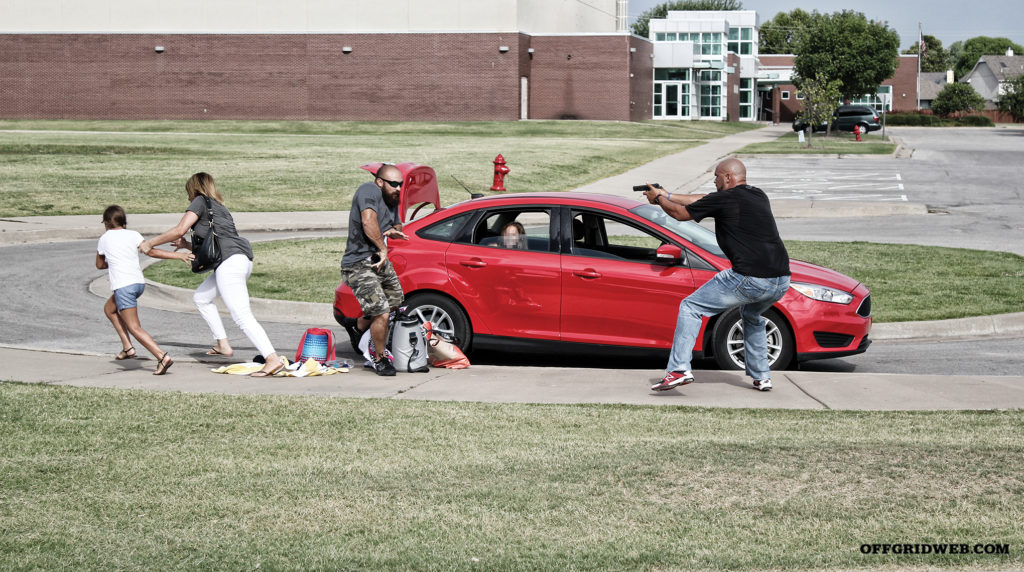
Above: Statistically, most carjackings target solitary drivers, but when other family members are involved, things quickly get much more complicated.
According to the NCVS study, about 38,000 carjackings occur each year in the U.S. Most take place in urban or suburban areas, generally not far from the victim’s home. Other revealing statistics from the report include:
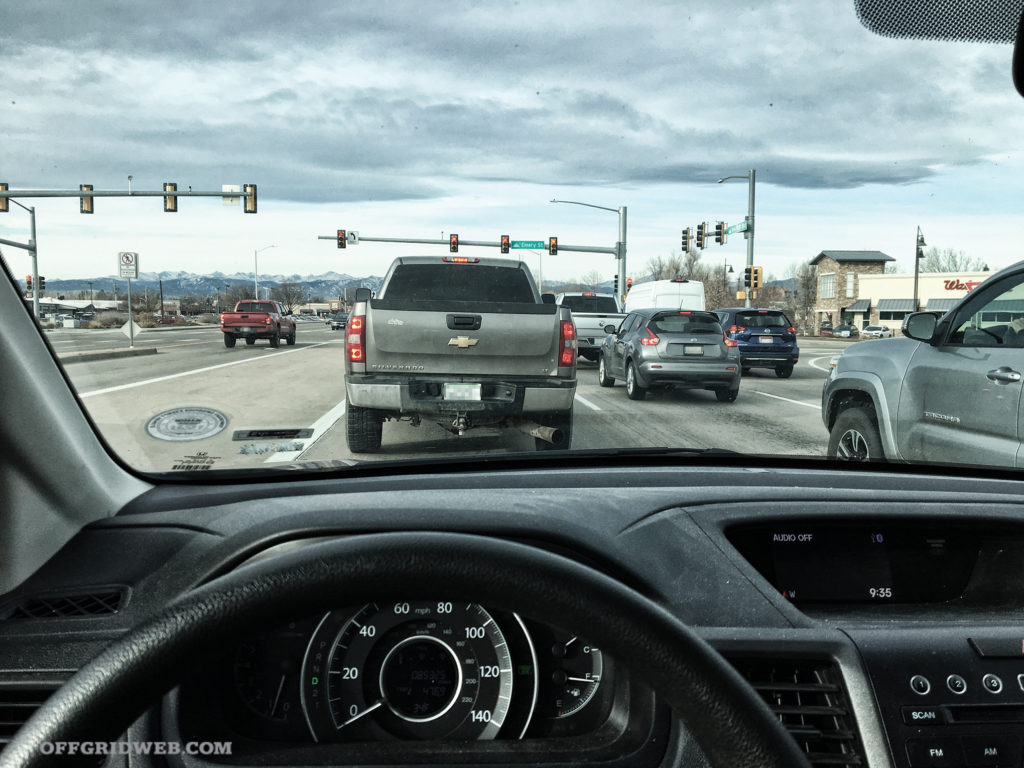
Above: Driving away from danger is always the best option. To preserve that option, don’t tailgate. When you stop behind another car, make sure you can see the rear tires so you’ll have enough turning radius to drive around if necessary.
These numbers paint a pretty clear picture of the circumstances of a typical carjacking. Armed with that knowledge, there’s a lot you can do to keep from being a victim. The more alert and aware you are, and the more precautions you can integrate into your daily habits, the safer you can be.
Even if you find yourself “behind the curve,” fighting back can still be a very viable option. According to the NCVS report, about 67 percent of carjacking victims resisted — most by running away and calling for help, and the remaining 24 percent by threatening, attacking, or chasing the offender. How effective was their resistance? About 32 percent of the victims of completed carjackings and 17 percent of attempted ones were injured, and most of their injuries were minor.

Above: Many carjackings occur as you approach or enter your vehicle. Stay alert and be prepared to fight back.
The first thing you need to understand and accept about carjacking is that your car isn’t worth dying for, but to a carjacker, it may be worth killing for. Put your personal safety above your car and your ego. If you’re surprised by a carjacker and have no other option, give up your keys and get away. Safe escape is always the ultimate victory.
To keep from being surprised, understand that carjackings typically happen in one of two ways: Either the carjacker approaches you as you enter or exit your car, or he approaches you while you are behind the wheel and your vehicle is stopped.
Anytime you’re approaching your vehicle, you’re vulnerable and need to be aware, avoidant, and ready to react. Here are some specific warning signs you should look for:
If you see something that concerns you, stop, maintain your distance, and use your vehicle and other things in the environment as barriers. Do not walk into a situation that makes you uncomfortable. If possible, go back and ask parking lot security or a friend to walk with you to your car.
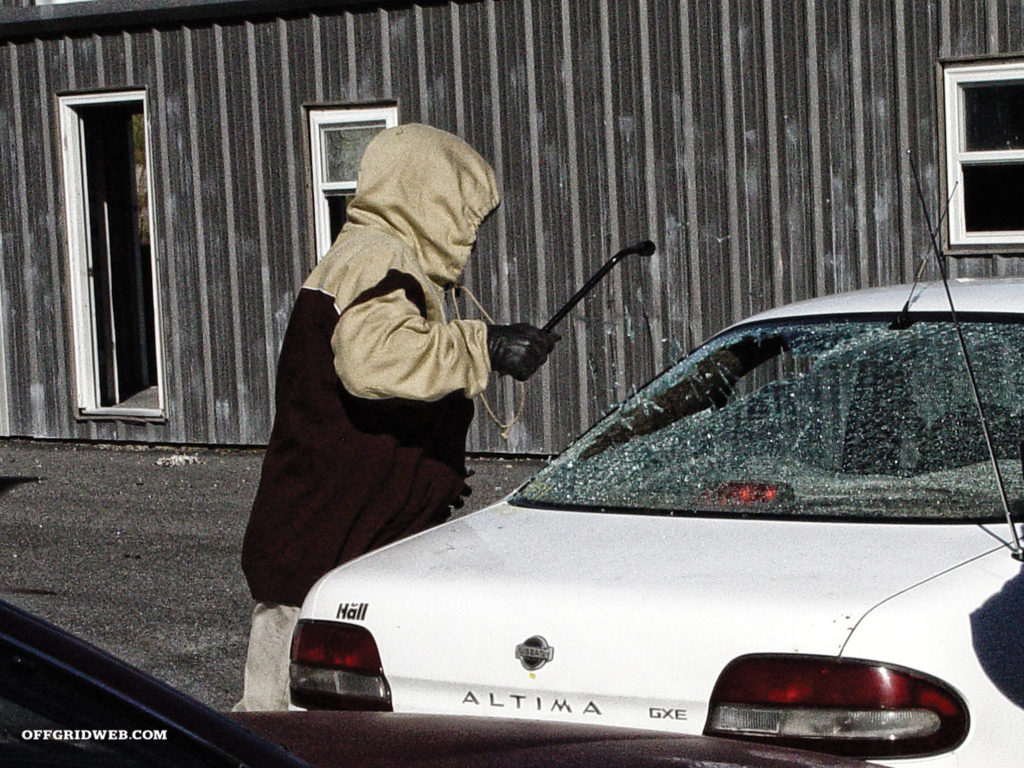
Above: Your vehicle is your best protection until its physical structure is breached. Once a carjacker has access to you, the danger level escalates rapidly.
You should also get in the habit of entering your car efficiently, maintaining awareness, and driving away in a timely manner. The longer you linger in your vehicle, the more vulnerable you are. Some specific behaviors you should adopt include:
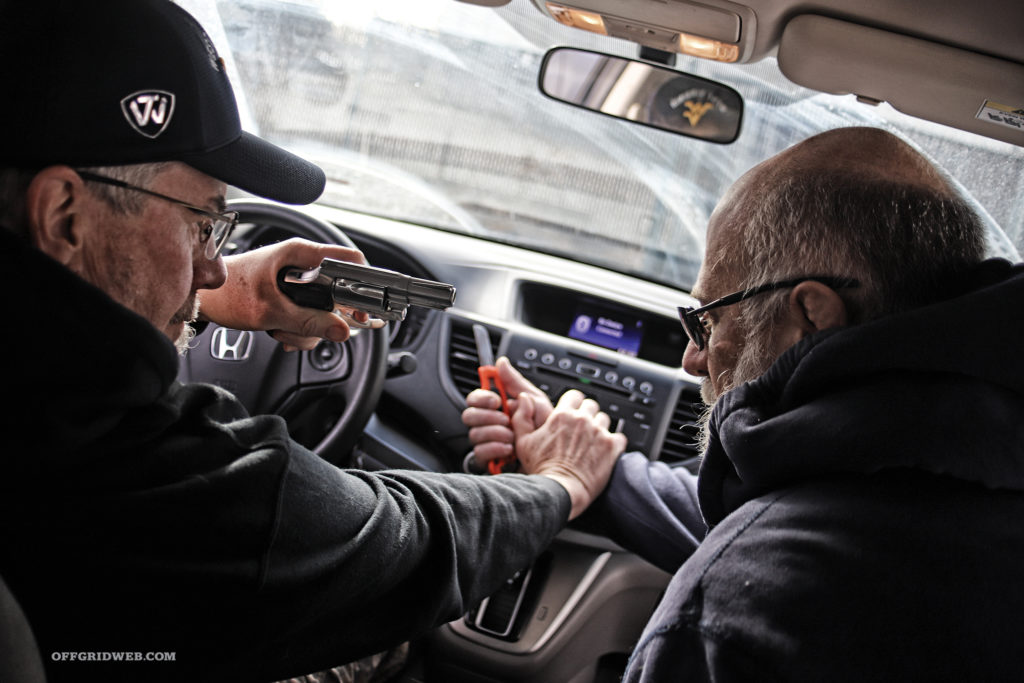
Above: Against a carjacker who’s able to get into your passenger seat, a gun set up for a left-handed draw makes weapon retention easier.
Exiting your vehicle can also be a time of vulnerability to carjacking. Some carjackers prefer to catch people unaware as they get out of their vehicles and before they “tune in” to their surroundings. Again, by keeping your head in the game and taking the time to apply a few simple tactics, you can significantly reduce your risk of falling victim to this type of attack. The tactics for exiting your vehicle safely include:
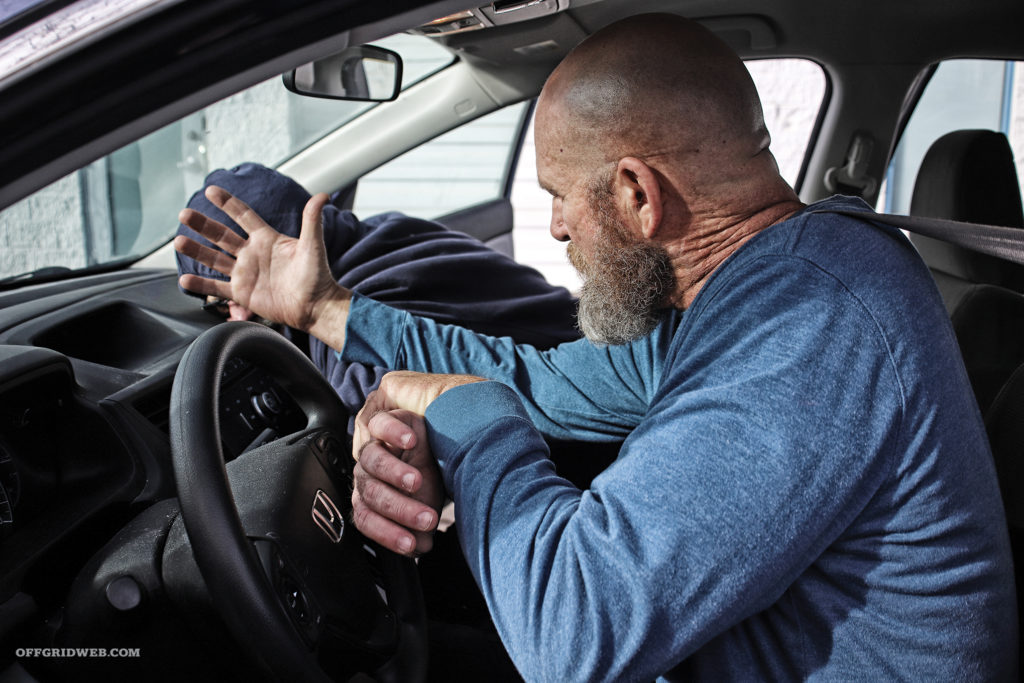

Above: If you have to fight unarmed in your car, control the carjacker’s near arm to use it as a barrier and use the dashboard and other surfaces inside the car to your advantage.
Carjackers may also attack while you’re behind the wheel of your vehicle, either stopped at a stoplight or “boxed in” by other cars. They may also intentionally bump your vehicle with theirs to draw you out. Depending upon the access you give them, they can threaten you with a weapon, physically attack you, or simply pull you out of the vehicle. Your first line of defense should be to make full use of the physical security your car offers.
If you’re attacked while in your vehicle, your best option is to drive away as quickly as possible. The key to maintaining that option is adjusting your driving habits as follows:
If you happen to drive a 1964 Aston Martin DB5 and your last name is Bond, your solution to carjacking is simple: a hidden button that fires a passenger ejector seat, as immortalized in the classic film Goldfinger. While that may seem crazy, technology-based countermeasures to the carjacking threat aren’t far behind that Hollywood gadget. Some, in fact, may have outdone it.
In South Africa, carjacking is extremely common, averaging about 44 incidents per day in 2018 and 2019 according to the country’s Department of Statistics. Because of the extreme threat of violent crime there, some citizens have taken a somewhat more “aggressive” approach to personal protection. One case in point was “The Blaster,” also known as the “BMW Flamethrower.” Invented in 1998 by Charl Fourie, it was quite literally a flamethrower mounted under the doors on each side of the vehicle. If a would-be carjacker approached the car while it was stopped, the driver could simply flip a switch and send a 15-foot jet of burning gasoline up toward his face. Although the inventor claimed it was intended to merely blind the assailant, a flamethrower is, by definition, a lethal weapon and its development was quite controversial. In light of the high rate of violent crime in the country, however, the Blaster wasn’t prohibited and remained on the market in 2001. Due to slow sales and a high price tag, production was ultimately stopped, but Blaster-equipped vehicles can still be found in South Africa.
If incinerating carjackers seems a bit much, Armormax — makers of custom-crafted armored cars — offers an electrified door handle option. Their system uses a power inverter to convert the vehicle’s 12-volt battery power into a 120-volt current that’s fed directly to the door handles. Flipping a switch inside the car arms the system and ensures that anyone attempting to open the doors gets a serious jolt.
More mundane approaches to countering carjackers with technology include kill-switches that disable a car’s electrical system, making it impossible to start. If hidden, but accessible, you might be able to discreetly hit the switch before surrendering your car. Some products have also combined kill-switches with proximity sensors that you keep on your body separate from your keys. If you’re separated from your vehicle by a specific distance — usually about a quarter mile — the kill-switch activates and the car goes dead.
Technology can certainly help, but the best way to keep from becoming a carjacking statistic is to develop good avoidance habits.
Countering a carjacking attempt with a gun is certainly a viable option, but it isn’t as easy as it may seem. If you have a CCW permit and carry regularly, you know that as soon as you get behind the wheel and buckle up, your standard draw-and-shoot style of gunfighting is severely cramped. Depending on where and how you carry, getting to your gun quickly can range from difficult to nearly impossible.
One way to overcome this problem is to hard-mount a holster, magnet, or similar device inside your car that enables you to position your carry gun — or a dedicated second gun — so it’s quickly and easily accessible when you’re in the driver’s seat. Even then, however, you need to wargame the various types of threats you might face and make sure the positioning of your gun is appropriate. If your biggest fear is someone getting in the passenger seat next to you, mounting your pistol in the center console might not be as wise as mounting it in the door and accessing it with your left hand. Conversely, if you’re mostly worried about threats outside the car, the center console makes sense, but you’ll need to know how to shoot out of the vehicle effectively.
If all this sounds complicated, it is. Fortunately, you can un-complicate with good training, like Florida Firearms Training’s “Bullets and Cars” course. This outstanding course not only teaches you the proper tactics of drawing and shooting in, from, and into a vehicle, it allows you to experience the unique ballistics of shooting through vehicles, including the often-counterintuitive effects of shooting through windshields and vehicle safety glass.
For more information, visit FloridaFirearmsTraining.com.
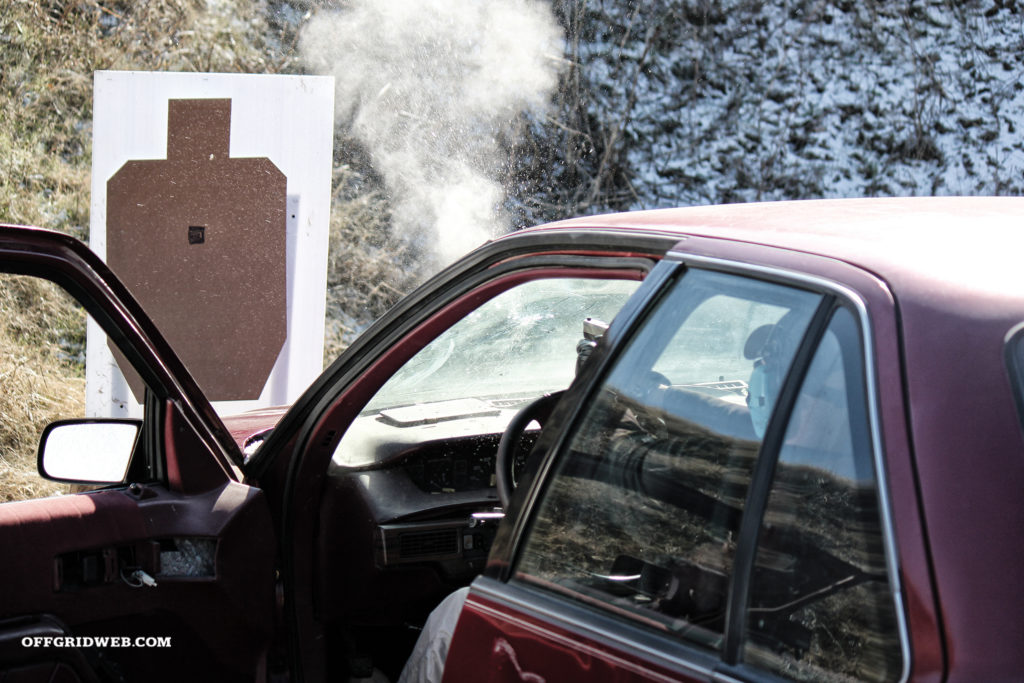
Above: Shooting through windshields changes your point of impact in surprising ways. The best way to understand that change is to experience it firsthand in the FFT course.
Fighting a carjacker should always be your last resort. Doing it effectively requires specialized training, sound weapon-acquisition tactics, and a solid understanding of the laws in your area. Gun-based defenses also run a high risk of collateral damage to innocent parties.
If you want these skills, go out and get the hands-on training you need to develop them. Otherwise, become a true “defensive driver” and focus on prevention rather than a cure.
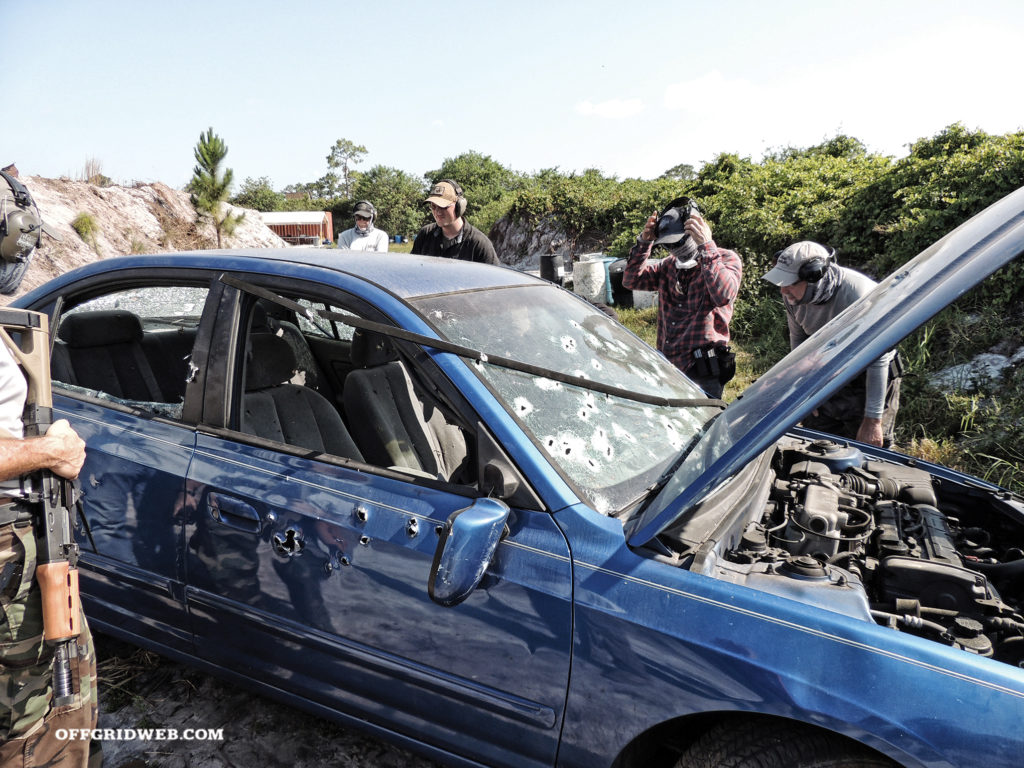
Above: Fighting in and around vehicles is a specialized problem that’s best solved with specialized training. Florida Firearms Training’s “Bullets and Cars” course is one of the best sources of this type of skill building.
 STAY SAFE: Download a Free copy of the OFFGRID Outbreak Issue
STAY SAFE: Download a Free copy of the OFFGRID Outbreak Issue
No Comments